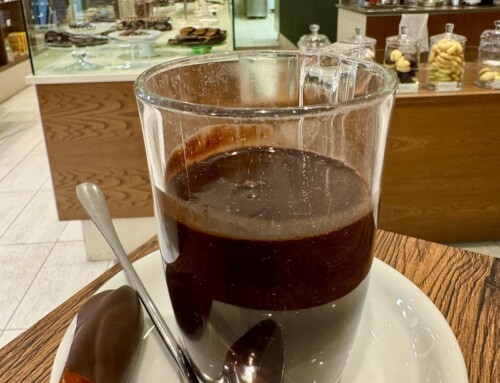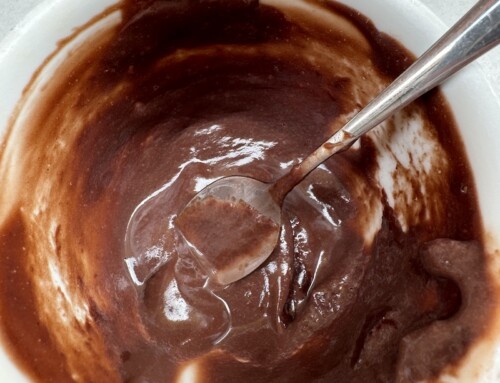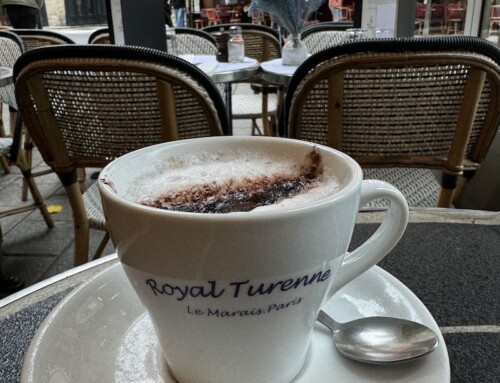
This morning I woke up wishing I was back in Basque country, so I thought I’d keep telling you about the hot chocolates I had there. So today we are back in Bayonne for another hot chocolate, this time at L. Raux Chocolatier. You may remember my post a few weeks ago introducing Bayonne, France’s capital of chocolate. This was a surprise to me too when I first found out. I had been to Bayonne before but never thought of chocolate, always of ham (Bayonne is even more famous for its Jambon de Bayonne, more on that later).


L. Raux Chocolatier has a beautiful location right on the square. Downstairs they sell food and pastries but upstairs there is a pretty large seating area to enjoy their treats. I go up and turn left, following my nose to the Bar a Chocolat. The hot chocolate here is prepared using ganaches. Ganache is what chocolate truffles are made out of. It is a mix between chocolate and cream. You simple heat the cream up just to the point it is starting to bubble and then pour that over chocolate. Whisk well and enjoy. I add in a touch of butter at the end when I make it to make it nice and glossy and smooth. Here the ganaches have been infused with 10 different flavours including caramel, praline, rose, coffee, earl grey, rum, mint, a milk chocolate and a Grand Cru 72% and an 85%. These are displayed much like ice cream is, each in its own little compartment. You choose the one you like, add hot milk, mix well and enjoy. I had the rum hot chocolate and it was beautiful and smooth. The portions are quite generous too.





Well, that is all I know. Lionel Raux doesn’t have a website so I wasn’t able to find out more. I asked a couple sitting close to me at the café who said that Mr. Raux is famous for his Gateaux Basque, a traditional dessert from this region. It is a buttery, soft crust filled with black cherries or pastry cream flavoured with almonds or rum and vanilla. It looks like a simple cake, but it really isn’t and the locals are very serious about their Gateaux Basque.
I’m not a fan of the “modern” candy pink and black interior at L. Raux Chocolatier, which isn’t a problem because there are large windows looking over beautiful Bayonne, the river and, most importantly Les Halles de Bayonne that I can focus on instead. The Basque country has some beautiful covered markets, and this is one of them. Inside you can buy everything that the region is famous for or take a seat at one of the cafes and sip Izarra, a traditional sweet liquor made in the region produced with 13 plants and spices. I watch as they set up white tents around the square in preparation for tomorrows Foire au Jambon (Ham Festival), an annual event celebrating the city’s specialty, Jambon de Bayonne.
Jambon de Bayonne is everywhere, you can even smell it in the air. Shop fronts have piles of sandwiches filled with Jambon and most chalkboard menus feature it. Since I was, unfortunately, going to miss the festival itself, instead I walked over to Pierre Ibaialde to take a tour and learn how this famous Jambon is made and of course taste some of the best.
My main takeaways are pretty obvious when you think about it. First, good pigs make good ham. Apparently, the Basque pigs are just as happy and well fed as the human residents are (at least for a while). These pigs roam freely so they snack on chestnuts, acorns, grass or whatever they find along the way (fine, not all of it is good, they have been known to chew on an old tired…). The legs from these pigs are cured in a very specific artisanal salt from the Pyrenees. It seems like a simple process but is of course not at all as simple as it seems and requires an incredible amount of knowledge which makers have accumulated over generations. About 7 to 10 months you have your ham. You can watch the whole process if you take the tour (only in French but take it anyways, its free) or read more from the pros here.



L. Raux Chocolatier, 7 rue bernadou, Bayonne, France





